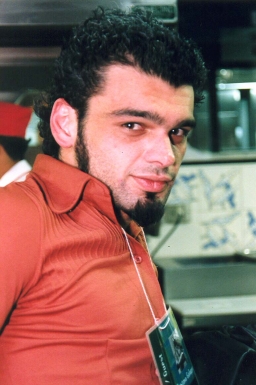Combinations of different elements of image production (including noises) and the characteristics of each one of them in a sum of all kinds of interferences feature in Gustavo Galuppo’s video work.
Galuppo, a young, award winning artist, makes use of his videos as a space in which images taken from films, domestic image fragments on Super-8, and the relation between text and image are connected in such a way that it reveals the transfers between supports and the hybridism of languages.
These videos address themes such as catastrophes and darkness, which are used as starting points for reflections upon love, death, and abandonment. Galuppo’s videos, based on texts by Godard and Marguerite Duras, as La progresión de las catastrofes (2004), combine in an interesting way formal research with cinema, memory and political issues. Galuppo seems to look for a way to transform the images into something less palpable or real, and more open to the construction of meaning generated through a rigorous process of editing.
Galuppo often makes use of written texts and subtitles as a way to extend and displace the meanings of his delirious video narratives, creating a tense relationship between text and image. We can realize it in the video La progresión de las catastrofes (2004), in which there is a scene taken from John Ford’s The quiet man (1952); in this scene, we can see a disfigured couple and a subtitled dialogue as if someone was making comments about their relationship, which is followed by the phrase: “No, nothing is so unforgettable as see in films“. This is a well constructed plot on the relation between text and image, questioning the status of images as a recording device for memory.
This same tense relationship between text and images features in other works by Galuppo. In the video El ticket que explotó (2002), based on the book The ticket that Explored, by William S. Burroughs, a text is overlaid on the image in such a way that the viewer cannot see clearly what is behind it and read the text at the same time, for the text becomes mixed with the colours of the images, revealing a mass of informational whose function is simply asthetic. Thus, the text becomes more an are also generated by Galuppo through intense formal and chromatic distortions.
This tense relation between text and image is continuously reinforced by soundtracks developed by the group Vera Baxter, which includes artists like Carolina Pina, Fernando Romero, and Galuppo himself. Suble nuances of sound are mixed with rhythmic electronic beats, producing nostalgic ambiences, as in La progresión de las catastrofes (2004), or aggressive ones, as in La persistencia de la oscuridad (teoria de los elementos igneos) (2000), highlighting the crudeness of the images and the very igneous elements, marked by extraordinary fire sounds in imageless sequences.
The works by Galuppo that we display in this edition of the FF>>Dossier reveal this peculiar method of appropriating images and re-creating them within a new framework, transforming them into “flux-images” that reveal the mutations of contemporary audiovisual and the idiosyncrasies of a video maker involved in the investigation of social and cultural phenomena, in way that seems to emphasize the vertigo.
Further info on this artist available at the collection
